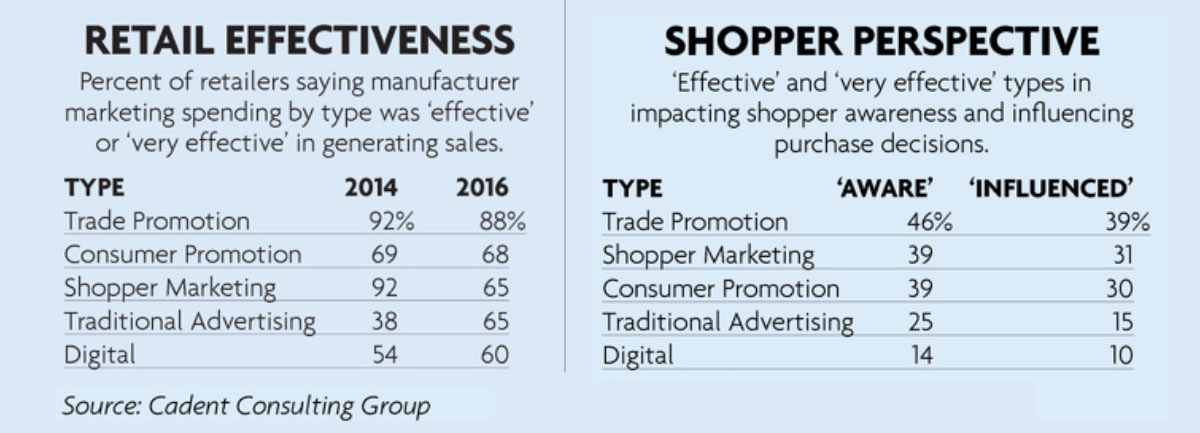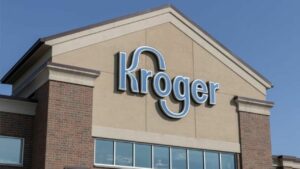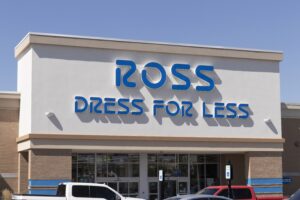
March 13, 2017
Are retailers ‘blind’ to digital marketing’s flaws?
Through a special arrangement, presented here for discussion is a summary of a current article from Frozen & Refrigerated Buyer magazine.
Spending by manufacturers on digital marketing has almost tripled in the past five years, from 7.7 percent of total marketing spending in 2012 to a projected 19.9 percent this year. Yet retailer and shopper impact has lagged.
That’s according to the just-released 2017 Marketing Spending Industry Study from Cadent Consulting Group.
With about $225 billion being spent annually on marketing, significant money is being redirected with an incomplete understanding of ROI, says Don Stuart, managing director at Cadent, and Karen Strauss, principal at Cadent and co-author. The study’s title, “Blinded by the Light” — a reference to Bruce Springsteen’s song made famous by Manfred Mann in the 1970s — alludes to the challenge.
“If you know the song you may remember it is next to impossible to understand. Well, that’s one predicament facing most sales and marketing executives at consumer companies today, when it comes to the ROI on marketing expenditures,” says Mr. Stuart, warning against “chasing after the bright, shiny new objects but not thinking about marketing ROI.”

As digital marketing channels have developed, spending has also become increasingly fractured.
“Social media is expected to continue to grow into 2017, representing $1 in every $4 spent in digital, but is considered less influential by shoppers than its share of budget,” the Cadent research says. Digital/banner and online coupons will be the second-largest components at about 16.5 percent each. Online coupons carry disproportionate weight with shoppers.
Cadent notes that while digital spending continues to grow, retailers seem less wowed by most types of it. While online coupons and social media remain the most effective in the eyes of the retailer, both have declined in effectiveness versus two years ago. Online coupons are seen as most effective, but fell from 83 percent in 2014 to 75 percent in 2016.
Shoppers say digital coupons are the most influential, whether they come from the retailer or the manufacturer. Brand and retailer websites each have the second highest awareness and influence among shoppers, with banners holding third place, the Cadent research says.
Discussion Questions
DISCUSSION QUESTIONS: Are retailers embracing digital advertising at the expense of traditional approaches? Do you think retailers should be more or less aggressive with digital marketing? Which approaches should get more or less attention?
Poll
BrainTrust
Sterling Hawkins
Co-founder, CART
Doug Garnett
President, Protonik
Recent Discussions







Balance is the key in using both in the most effective way. I am seeing marketing activities come full circle to the industry, whether it be among retailers or solution providers. I have also been “blinded by the light” of social media as the default answer when traditional media such as trade publications both in print and online can be a much more effective way to reach decision makers who have the “juice” to make something happen. Yes, use social, but only as one tactic among many.
Zel is 100% right; balance is key as no one channel works for all consumers. Once content is created (offers, recipes, etc.), it requires a little customization to make it appropriate for each channel (ex. a full TV commercial often isn’t appropriate in a mobile environment). Meeting consumers where they are is part of a retail strategy that takes a step past omnichannel and moves towards truly unified commerce.
The power of the status quo is debilitating and to not exploit the enabling capability of digital branding and merchandising is to die while asleep. Brands that have long used digital media have lived with a level of acceptable ignorance in the knowledge that it works, despite significant ROI analysis. This lack of impact assessment is really too bad because it can provide little basis for optimizing the use of the tools and for validation of larger investment. The great inflection point toward success is in the realization that things may have to be done differently. Enabling technologies provoke this awareness.
Retailers seem to have been hesitant to shift ad spend to more personalized and relevant channels like loyalty and promotions around coupons, which have consistently shown to be more valuable to both retailers and consumers. This is cultural and not based on analytic data. Retailers MUST begin shifting some of their ad spend in areas that do not perform in order to remain “sticky” with their shoppers. It’s time to start being realistic and honest about traditional ad performance. Listen to your customers!
Digital marketing does not necessarily mean online. TV is digital, for example. That said, I think the biggest issue I see is a lack of strategy. Most advertising from brands is a hodgepodge of tactics, not a defined strategy. The CEO says, “we need to do online” and someone jumps and starts running display ads with a coupon.
Social media is totally misunderstood. I see brands and retailers pushing deals and specials constantly and failing at it. Social media is SOCIAL. It is an opportunity to engage with your consumers. It is a soft sell.
Online marketing is a totally different approach and most brands and retailers don’t understand it. They are so entrenched in the circular and discount mode that they do not understand how to properly use online strategies like native ads and content marketing to engage with their consumers.
It is not the marketing channel that is flawed. It is the tactic.
The “shotgun” approach of throwing money at all types of digital and hoping you’ll see some ROI is futile. Digital has some great leverage potential, however you need to determine the bang for the buck just like traditional methods of marketing. The trouble is, most marketers still struggle to show real ROI even with traditional methods. So digital tends to cloud the effectiveness of overall marketing efforts if it is not productively managed. Digital marketing tactics like real-time personalization, for instance, are driving huge results for retailers as we speak. The innovators are using ROI models that capture the relevant data to paint a next best action nurture stream campaign to make digital stronger the more data it collects over time. That’s machine learning. Cognitive. It’s working. And it’s truly the future.
Digital is like every other media — it works when tightly targeted and seldom pays back in the typical “spray and pray” approach. Digital is definitely the “shiny new object” — but a little bit of that is nomenclature (sort of like the way in-store demos have become “experiential marketing”) — digital can either be direct mail on a different device or it can be broadcast advertising. It’s all about using the right approach for the right purpose. And yes, John Wanamaker, half of our advertising dollars are still wasted — and we still don’t know which half.
Digital is nothing more, or less, than a type of media with strengths and weaknesses. What’s distracting marketers with it, though, is that it is constructed for marketers to be able to sell it within internal politics — without serious consideration of the effect on their overall mix of media.
So yes, marketers are using digital too often and to do jobs it doesn’t do well. Even worse, what they won’t ever know is what they are losing with digital’s claim to hyper-target the “best” consumers. In fact, digital only targets those who have taken online steps that make them appear to be in the target zone. Far, far more are in the target zone but haven’t taken those steps and will never see digital ads.
By contrast, traditional media is always reaching a broader set of possible consumers — creating next generations of shoppers/buyers that digital misses.
Unfortunately, it takes a particularly wise marketer to avoid the seduction of the important sounding but shallow, metrics that surround digital. After all, company politics usually reward those with any metric (even if it’s a misleading and erroneous metric).
Fortunately, there is finally some excellent writing about the errors made with digital by the likes of Mark Ritson and Bob Hoffman (@adcontrarian on Twitter) digging into where we’ve been misled.
Clearly “share of mind” of consumers and shoppers is higher in mobile and online media than in traditional media, and the gap grows with each new consumer generation. However, “share of spending” is still proportionally skewed towards traditional media. This is because of inertia, lack of ROI analysis and other “political” factors. When retailers and brands invest in digital channels, the effect of being “blinded by the light” is indeed noticeable. Many of these investments are hype-based without a real strategy behind them, based on choosing the easier/faster way which is not necessarily the effective one. Social media campaigns have their place within the marketing mix, but social media shouldn’t be the prime channel. Personalized coupons, customer-centric campaigns, relevant content through multiple channels, user-friendly UI on mobile apps, digital merchandising and many other digital-related channels must be considered and analyzed.
Retailers should be using data analytics to inform their digital marketing strategies. With the insights gained from deep analysis of their shopper data, retailers can better understand their target shoppers and develop digital marketing programs with positive ROI.
It’s a fact of retail that online channels are gaining in strength while brick-and-mortar faces major challenges, and retailers must recognize this trend and put meaningful marketing dollars into supporting those online channels rather than seeing online as secondary. As such, retailers do need to be more aggressive with digital marketing, and they must take full advantage of all it has to offer. This includes the ability to gather useful metrics on what motivates customers to buy, what their emotional connections may be to your brand and how those customers are most likely to act in the future. In addition to taking full advantage of digital data, retailers must recognize that one of the biggest emotional motivators, especially among Millennial shoppers, is the desire to see their retailers as real people. That means using social media outlets as more than just a trumpet for broadcasting sales — social media is most effective when it is used as a listening post, to hear what customers are saying about you, and as a telephone, to hold meaningful, two-way discussions with them.
Food retailers just need to keep up the pulse on digital. Why? Generation X, Generation Z and Boomers all grew up using one method of food shopping. They were young once and they have yet to sort out the grocery cart, mom/dad memories and food shopping. Digital change is happening fast but more in the new areas or areas that people hated to shop with their parents when growing up. Do not go too fast on digital in food and keep it simple.
I think retailers need to figure out where their customers are — physically and digitally — and advertise accordingly. We are way past the days when one could seriously suggest there is a magic wand or secret formula out there that guarantees success. Retailers have to stop grabbing every bright and shiny thing that comes along. It takes research, facts and innovative strategies to create a successful ad program today — but it all starts by deepening your understanding of your target customer.
In the supermarket sector retailers are mixing the various forms of marketing, digital and traditional, to various degrees with larger retailers generally engaging in more of a variety. However, many retailers have been slow to come to the party in this sector so I don’t think they are embracing digital at the expense of traditional for the most part at this point. It is important to look forward and develop the right blend of marketing tools for the present AND for the future in order to remain relevant. In some cases this will generate solid ROI and in others it will be experimental.
Who are your consumers and shoppers? What is the goal of your marketing? Answer those questions and then figure out what media (broadcast, billboards, social media, sales promotion) work with your consumer touch points. Then design your marketing plan across all forms of media you plan to use AND metrics for assessing results. Otherwise you are still guessing which half of your promotion budget works.
There is something missing from the discussion and that is industry-standard audience measurement, which digital media does not provide. Even vaunted P&G is considering to back off digital media until it gets third-party audience measurement accredited by the Media Rating Council.
It’s hard enough for a retail CMO to drive traffic, but to prove the ROI on digital media to the C-suite is even more difficult. All agree the path to purchase has changed. Digital media, from desktop to mobile and display to social, is a major factor in the shift. The issue is not whether to invest in digital media, but how much risk is one willing to take on?
Plus there are tech issues: tracking cookies slow down site load times which sites do not want. “Performance degradation” it’s called. For big box stores, media budget is typically larger than CAPEX. A media director often manages a larger budget than the treasurer. And in a tumultuously consolidating industry with a constant call to do more with less, every red cent needs proof before being committed. Therein lies the rub.
Or as Mel Karmazin might say, “retail ain’t for sissies!”
The rise of m-commerce has led to major shifts in the e-commerce world. Online retailers are already redesigning their sites to better serve the increasing number of shoppers who are visiting online stores and making purchases from their mobile devices. Checkout pages are becoming more streamlined, navigation systems are being tailored to mobile screens, and product pages are being revamped. Similar to how the rise of m-commerce is transforming the design of online stores, it is also leading to significant shifts in marketing tactics.
Digital marketing provides an opportunity for retailers to better connect with their customers from any device, anywhere. However, failing to carefully tailor marketing strategies to the individual shopper can significantly impact ROI–any effective digital marketing strategy must be targeted and personalized. Leveraging quality data is an important component in ensuring this personalization, as it perfects customer loyalty through tactics such as rewards programs, promotions based on past purchases, and product recommendations.
Although digital marketing is becoming increasingly important, as it offers a clear path to mobile shoppers, it is just one piece of the marketing puzzle. To reach the full spectrum of consumers and maximize ROI, retailers need to leverage a multi-pronged marketing strategy that emphasizes both traditional and digital tactics.
When all is said and done, the big winner will be digital coupons. It will be generational. Everyone carries a smartphone.
In this context I feel compelled once again to echo the media sage Marshall McLuhan’s observation that new media displace — but do not replace — old. For retailers that means (in part) that the existence of digital and social media options does not make traditional channels obsolete. It does affect how we use them, however.
I’d posit several factors to explain retailer’s media shift toward digital marketing — fad, experimentation, imputed shopper interest, promises from media vendors, hoped-for cost control. Certainly a dollar invested on Facebook marketing is not available for a print ad in the newspaper, so the shift is real.
As a group, I think retailers have not come close to being artful in their digital marketing methods. The media environment is chaotic. Trends and platforms evolve and expire rapidly. Shoppers have many choices and distractions and may seem fickle. Attribution and ROI keep getting harder to quantify.
But if the data reveals that shoppers favor the convenience of digital coupons linked to their frequent shopper cards, it behooves retailers to deliver them, and pay close attention to the response.
Most consumers and a large percentage of retailers don’t understand what digital marketing is. Asking someone to judge effectiveness who has little understanding is pointless. Digital marketing starts with a website. In addition to web design/development, there are four distinct types of digital marketing. SEO, SEM, Email and Social.
Digital marketing seems to be more cost effective than traditional marketing. The cost of a mailing or a TV or radio commercial is much higher than the cost to capture someone on a social channel — or even email. How many people are on digital (commercial free) radio versus traditional radio? How many people really watch TV (other than sports and news) on a recorded device versus in real time? And, how many of those watching TV on the recorded device don’t speed through the commercials? I think you see where I’m going with this.
So, assuming your customers are listening to commercial free Sirius Radio and speeding through commercials of their favorite recorded TV shows, digital advertising seems to be a very viable option — if not the best option for some retailers.
For the most part, retail is slow to adapt; whether it’s IoT, marketing made to deliver value on mobile channels or understanding the impact of digital savvy consumers. I heard talks at NRF that related the paradigm of “digital natives” as something new, but consumers have been mobile natives for 5-10 years.
Coupons and QR code offer have to be mobile-friendly and digital, and that’s exactly what we are seeing in grocery and fast-food industry segments. Retailer’s don’t effectively harness video content, corporate social responsibility or leverage data very well. Most still do multi-channel instead of integrated omnichannel.
Mobile first strategies that leverage artificial intelligence and move retailers into the age of IoT would go further than legacy advertising and digital marketing that’s pay to play and has less ROI.
One of the greatest benefits of digital marketing is the accountability. With the exception of social media, most digital marketing should be trackable. That does not mean that it is easy to track. The gap for most marketers is attribution modeling, which identifies the combination of actions that drive incremental sales. Detailed test plans (A/B and multivariate), combined with strong web metric tools, provide the tools that will permit marketers to better understand the impact of their digital marketing.